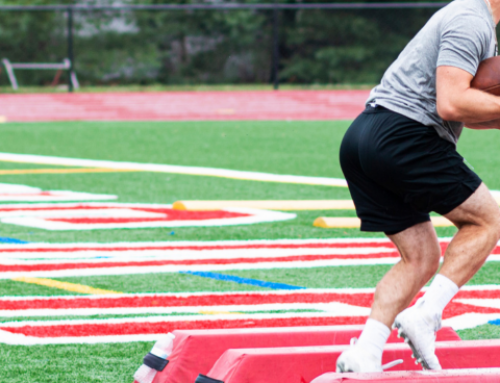Get in Football Shape Fast With Metabolic Runs
![]()
Maximal bursts of speed and agility are all-important for football performance, and your conditioning program should reflect that. But you also need to train like you play. A defensive back, for example, should cover a much greater distance than a lineman, since he has to jog back a greater distance to the line of scrimmage.
High school football generally consists of longer plays and shorter rest periods—a more strenuous work-to-recovery ratio compared to college and the NFL. You have to adapt your conditioning to the tempo and workload of your specific game.
A metabolic series is a great way to get a head start before pre-season training. You should come into the pre-season in shape and ready to go. It’s what you do during your off-season that will determine your success.
The Football Metabolic Training Program
This metabolic interval training program includes two days of one-hour sessions done after a movement preparatory routine, along with any drills you need to work on. See 12 Dynamic Stretches Football Players Must Do.
The main set should be done at maximal intensity, speed and effort, since that is what’s required in every play during a game. Interval training for a football player should take place at close to maximum speed to avoid altering run mechanics, stride frequency and stride length. Remember, “train like you play.”
The sample program is for two days per week. Metabolic interval training should be limited to two to three days per week, considering that resistance training and drills should also be performed. If you are in shape, a third day of stairs or hill work would be great.
Start with 2 sets and work up to 3 to 4 sets over 6 weeks.
Day 1
- Pacman Drill x 2 reps. Pacman Drill is similar to the Icky Shuffle, using cones. See video above for a demonstration. Sprint 10 yards out of the drill. Reps/Sets: 2×2 with 20-30 seconds rest between reps.
- Burpee into 10-yard sprint x 2 reps. Perform a Burpee, then immediately burst into a 10-yard sprint. Rest 30 seconds between reps.
- 20-yard sprint (10-yard sprint for linemen) x 2 reps. Rest 20 seconds between reps.
- 40-yard sprint (20-yard sprint for linemen) out of 3-point stance (if working on 40-yard starts) or position stance x 2 reps. Rest 35 seconds between sets.
- Position-specific drill. Example for defensive back: backpedal 5 yards, sprint 10 yards, shuffle right 5 yards, shuffle left 5 yards, sprint 10 yards. Perform 2 reps with 60 seconds rest between. This is your chance to work on something specific for your position and to work the same muscles you will be using during practice, which will help you be prepared and decrease muscle soreness.
Rest for 3-5 minutes before performing a second set of the whole series.
Day 2
- Pacman Drill x 2 reps. Sprint 10 yards out of the drill. This time, when you sprint out, sprint diagonally rather than straight. If you have a buddy pointing out the direction, all the better because it works your reaction. Performs two sets with 20-30 seconds rest between.
- 20 yard sprint (10-yard sprint for linemen) out of 3-point stance (or position stance) x 2 reps. Rest 20 seconds between reps.
- 4-Cone Drill x 4 reps. Set up 4 cones or markers 5 yards apart in a box. Vary the drills. Example: sprint to cone 1, side shuffle to cone 2, backpedal to cone 3, turn and sprint to cone 4. Rest for 40-60 seconds between reps.
- Burpee into 10-yard sprint. Perform a Burpee (with a Push-Up) then sprint from the goal line to the 10-yard line. Repeat this sequence until you reach the 40-yard line. Rest for 80 seconds and repeat.
Rest for 3-5 minutes before performing a second set of the whole series.
RELATED: Metabolic Conditioning With Sprints: Get in Shape Fast
References:
- Cissik, J. M. (2005). “Means and methods of speed training: Part II.” Strength and Conditioning Journal, 27(1), 18-25.
- Hoffman, J. R. (2008). “The applied physiology of American football.” International Journal of Sports Physiology and Performance, 3, 387-392.
- Rhea, M. R., Hunter, R. L., & Hunter, T. J. (2006). “Competition modeling of American football: Observational data and implications for high school, collegiate, and professional player conditioning.” Journal of Strength and Conditioning Research. 20(1), 58-61.
- Veale, J. P., Pearce, A. J., & Carlson, J. S. (2010). “Reliability and validity of a reactive agility test for Australian football.” International Journal of Sports Physiology and Performance, 5, 239-248.
RECOMMENDED FOR YOU
MOST POPULAR
Get in Football Shape Fast With Metabolic Runs
![]()
Maximal bursts of speed and agility are all-important for football performance, and your conditioning program should reflect that. But you also need to train like you play. A defensive back, for example, should cover a much greater distance than a lineman, since he has to jog back a greater distance to the line of scrimmage.
High school football generally consists of longer plays and shorter rest periods—a more strenuous work-to-recovery ratio compared to college and the NFL. You have to adapt your conditioning to the tempo and workload of your specific game.
A metabolic series is a great way to get a head start before pre-season training. You should come into the pre-season in shape and ready to go. It’s what you do during your off-season that will determine your success.
The Football Metabolic Training Program
This metabolic interval training program includes two days of one-hour sessions done after a movement preparatory routine, along with any drills you need to work on. See 12 Dynamic Stretches Football Players Must Do.
The main set should be done at maximal intensity, speed and effort, since that is what’s required in every play during a game. Interval training for a football player should take place at close to maximum speed to avoid altering run mechanics, stride frequency and stride length. Remember, “train like you play.”
The sample program is for two days per week. Metabolic interval training should be limited to two to three days per week, considering that resistance training and drills should also be performed. If you are in shape, a third day of stairs or hill work would be great.
Start with 2 sets and work up to 3 to 4 sets over 6 weeks.
Day 1
- Pacman Drill x 2 reps. Pacman Drill is similar to the Icky Shuffle, using cones. See video above for a demonstration. Sprint 10 yards out of the drill. Reps/Sets: 2×2 with 20-30 seconds rest between reps.
- Burpee into 10-yard sprint x 2 reps. Perform a Burpee, then immediately burst into a 10-yard sprint. Rest 30 seconds between reps.
- 20-yard sprint (10-yard sprint for linemen) x 2 reps. Rest 20 seconds between reps.
- 40-yard sprint (20-yard sprint for linemen) out of 3-point stance (if working on 40-yard starts) or position stance x 2 reps. Rest 35 seconds between sets.
- Position-specific drill. Example for defensive back: backpedal 5 yards, sprint 10 yards, shuffle right 5 yards, shuffle left 5 yards, sprint 10 yards. Perform 2 reps with 60 seconds rest between. This is your chance to work on something specific for your position and to work the same muscles you will be using during practice, which will help you be prepared and decrease muscle soreness.
Rest for 3-5 minutes before performing a second set of the whole series.
Day 2
- Pacman Drill x 2 reps. Sprint 10 yards out of the drill. This time, when you sprint out, sprint diagonally rather than straight. If you have a buddy pointing out the direction, all the better because it works your reaction. Performs two sets with 20-30 seconds rest between.
- 20 yard sprint (10-yard sprint for linemen) out of 3-point stance (or position stance) x 2 reps. Rest 20 seconds between reps.
- 4-Cone Drill x 4 reps. Set up 4 cones or markers 5 yards apart in a box. Vary the drills. Example: sprint to cone 1, side shuffle to cone 2, backpedal to cone 3, turn and sprint to cone 4. Rest for 40-60 seconds between reps.
- Burpee into 10-yard sprint. Perform a Burpee (with a Push-Up) then sprint from the goal line to the 10-yard line. Repeat this sequence until you reach the 40-yard line. Rest for 80 seconds and repeat.
Rest for 3-5 minutes before performing a second set of the whole series.
RELATED: Metabolic Conditioning With Sprints: Get in Shape Fast
References:
- Cissik, J. M. (2005). “Means and methods of speed training: Part II.” Strength and Conditioning Journal, 27(1), 18-25.
- Hoffman, J. R. (2008). “The applied physiology of American football.” International Journal of Sports Physiology and Performance, 3, 387-392.
- Rhea, M. R., Hunter, R. L., & Hunter, T. J. (2006). “Competition modeling of American football: Observational data and implications for high school, collegiate, and professional player conditioning.” Journal of Strength and Conditioning Research. 20(1), 58-61.
- Veale, J. P., Pearce, A. J., & Carlson, J. S. (2010). “Reliability and validity of a reactive agility test for Australian football.” International Journal of Sports Physiology and Performance, 5, 239-248.











